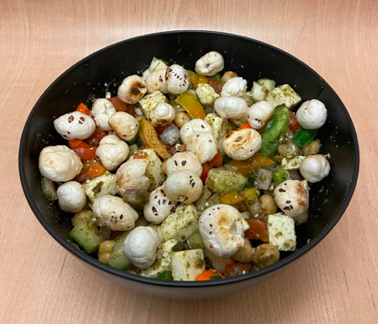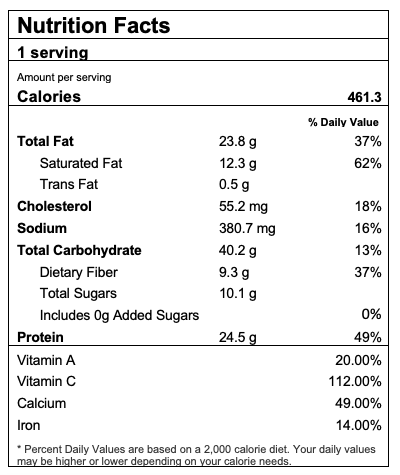This cold chickpea, lotus seed, and paneer salad is full of protein, healthy fats, and diverse vegetables which add a burst of flavor in your mouth. This recipe is easy to make, and the ingredients can easily be stored in the fridge for a week. Ingredients can be assembled when needed and can be enjoyed for lunch, dinner, or even a snack. This recipe is inspired by the Mediterranean diet, including legumes, vegetables, and olive oil along with some Asian ingredients such as paneer and lotus seed. This recipe is also gluten free and vegetarian. It can be made vegan by omitting paneer and instead using extra firm tofu.
Ingredient Highlights
Chickpeas: This is a good source of plant protein and fiber. It also contains folate, iron, phosphorus, and polyunsaturated and monounsaturated fatty acids such as linoleic and oleic acids. Chickpeas may help prevent chronic diseases such as diabetes, obesity, and cardiovascular diseases. They also help maintain a healthy gut microbiome. Roasted or ground forms of chickpeas have even been used as a caffeine-free alternative to coffee [i].
Dry Lotus Seeds: Lotus seeds were originally found in Asian countries such as China, India, and Japan. Lotus seeds have also been a part of Iran and Egypt. They contain good amounts of proteins, carbohydrates, and are low in fats. Minerals such as phosphorus, calcium, magnesium, and iron are also present in them. Lotus seeds contain antioxidants and may have anti-inflammatory and anti-cancer effects. They can be easily found in Asian and Indian grocery stores, or purchased online [ii].
Paneer: Paneer has a great importance in the Indian vegetarian diet because of its high level of fats and proteins. It also contains good amounts of phosphorus, calcium, vitamin A, and vitamin D. Clinicians recommend paneer for diabetic and coronary heart patients. Whey proteins, which are a rich source of vital amino acids, are responsible for paneer’s superior nutritional value [iii].
Tomatoes: As a significant source of lycopene, a type of carotenoid phytochemical with a red hue, tomatoes are somewhat unusual in this regard. This carotenoid is the subject of a large portion of research on tomatoes and cancer. Tomatoes are also a good source of vitamin C, vitamin A, phytoene, Beta-carotene, and phytofluene [iv].
Carrots: With their abundant quantity of carotenoids and other phytochemicals, carrots have the potential to lower the risk of several chronic conditions [v].
Bell Peppers: Bell peppers are very nutrient-dense. Carotenoids, vitamin C, and vitamin E are all found in them. Additionally, they include compounds with a variety of health advantages such as phenols, flavonoids, carotenoids, tocopherol, and pectic polysaccharides. These bioactive substances may have anti-inflammatory, antioxidant, antibacterial, antifungal, and anti-diabetic activities [vi].
Recipe
Chickpea, Lotus Seed, and Paneer Salad

Ingredients
- 1 can (15 oz) chickpeas, rinsed and drained
- 1 cup dry lotus seed
- 1 cup paneer
- 1 medium cucumber, chopped
- ½ medium red bell pepper, chopped
- ½ medium yellow bell pepper, chopped
- ½ medium green bell pepper, chopped
- 1 medium tomato, chopped
- ¼ cup edamame beans, cooked
- ¼ cup corn, steamed
- ½ cup red onion, chopped
- ¼ cup carrots, chopped
- ½ cup mint, chopped
- 1 medium jalapeno (remove seeds, optional)
- 2 Tbsp extra virgin olive oil
- 1 Tbsp lemon juice
- Salt to taste
Instructions
- Heat a pan over medium flame for 2 to 3 minutes and roast the lotus seed on the stove while stirring continuously. After 4 to 5 minutes of roasting, they will start turning slightly brown. Taste them and if you want more crunch, roast them for a couple more minutes. Once done, set aside and let cool.
- For dressing: In a blender add mint, jalapeno, olive oil, lemon juice and blend until you achieve a desired consistency.
- In a bowl add chickpeas, paneer, cucumbers, bell peppers, tomato, edamame, corn, red onion, carrots, dressing, and salt to taste. Mix everything.
- Add roasted lotus seed in your bowl just before serving so that they do not become soggy.
Notes:
- Chickpeas can be substituted with any dry or canned beans, peas, and lentils (legumes) of your choice.
- Canned low sodium chickpeas can be used or rinse them well to remove excess sodium content.
- Any vegetables of your choice such as avocado or zucchini can be added. Roasted cauliflower or broccoli can also be added.
- For the dressing, coriander or basil can be added for the flavor.
- Prechopped or frozen vegetables can be used to reduce the preparation time.
- Many American local grocery stores may not contain paneer block. Instead, extra firm tofu can be used.

References:
[i] Chickpeas (garbanzo beans). The Nutrition Source. (2022, March 2). Retrieved November 21, 2022, from https://www.hsph.harvard.edu/nutritionsource/food-features/chickpeas-garbanzo-beans/
[ii] Arooj, M., Imran, S., Inam‐ur‐Raheem, M., Rajoka, M. S., Sameen, A., Siddique, R., Sahar, A., Tariq, S., Riaz, A., Hussain, A., Siddeeg, A., & Aadil, R. M. (2021). Lotus seeds (nelumbinis semen) as an emerging therapeutic seed: A comprehensive review. Food Science & Nutrition, 9(7), 3971–3987. https://doi.org/10.1002/fsn3.2313
[iii] Kumar, S., Rai, D. C., Niranjan, K., & Bhat, Z. F. (2011). Paneer—an Indian soft cheese variant: A Review. Journal of Food Science and Technology, 51(5), 821–831. https://doi.org/10.1007/s13197-011-0567-x
[iv] Tomatoes: Major source of lycopene. American Institute for Cancer Research. (2021, August 3). Retrieved November 21, 2022, from https://www.aicr.org/cancer-prevention/food-facts/tomatoes/
[v] Carrots: Rich supply of carotenoids. American Institute for Cancer Research. (2021, August 2). Retrieved November 21, 2022, from https://www.aicr.org/cancer-prevention/food-facts/carrots/
[vi] Anaya-Esparza, L. M., Mora, Z. V.-de, Vázquez-Paulino, O., Ascencio, F., & Villarruel-López, A. (2021). Bell Peppers (capsicum annum L.) losses and wastes: Source for food and pharmaceutical applications. Molecules, 26(17), 5341. https://doi.org/10.3390/molecules26175341
